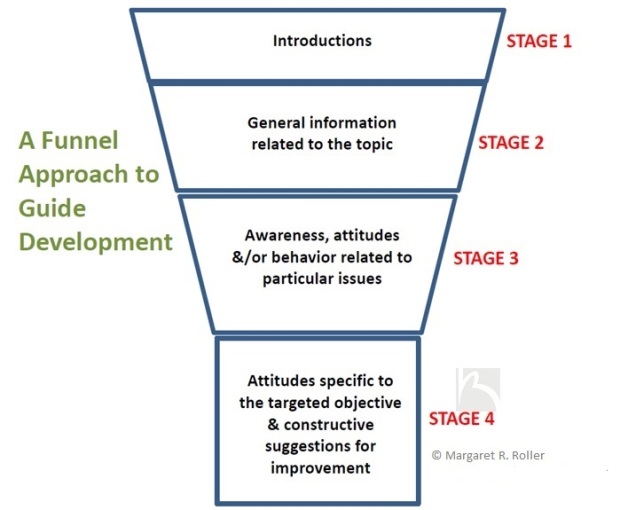In-depth interviewers and focus group moderators typically work from an outline of relevant topics and questions that guides them  through the interview or discussion. The guide is intended to be just that, a guide, and not a strict, prescriptive document. With the guide, the ultimate goal is to enable the interviewer or moderator to efficiently incorporate all of the issues that are important to achieving the research objectives. Maintaining clarity throughout the interview or discussion on the related issues is actually a more essential purpose of the guide than the actual questions or follow-up probes it may contain.
through the interview or discussion. The guide is intended to be just that, a guide, and not a strict, prescriptive document. With the guide, the ultimate goal is to enable the interviewer or moderator to efficiently incorporate all of the issues that are important to achieving the research objectives. Maintaining clarity throughout the interview or discussion on the related issues is actually a more essential purpose of the guide than the actual questions or follow-up probes it may contain.
The most typical and effective approach in constructing an interview or discussion guide is to begin broadly and progressively narrow the topic area to the subject matter of greatest importance to the research objectives, i.e., a “funnel” approach. The funnel consists of four basic stages.
Stage 1: Introductions
The interviewer or moderator introduces themself, briefly explains the purpose of the research, the use of audio/video recording, participant’s anonymity, etc., and allows the participant(s) to comment or ask questions.
The participant(s) introduce themselves by way of answering a few simple questions related to the research objective. For example, in a focus group study with new homeowners concerning their recent mortgage process, the researcher might begin by asking participants how they picked the home they did and one or two things they love about living there.
Stage 2: General information related to the topic
This stage provides background and context to the topic broadly defined, giving the researcher a necessary perspective from which to pursue certain questioning as well as conduct an informed analysis at the conclusion of the research. In the study with new homeowners, this stage might include a discussion about their attitudes toward the mortgage loan process.
Stage 3: Awareness, attitudes &/or behavior related to particular issues
At this stage, the interview or discussion begins to home in on the ultimate objective of the research. Now, for instance, the new homeowners might be asked about their recall and attitudes toward the various mortgage documents (the real focus of the study) they reviewed and signed during the mortgage process.
Stage 4: Attitudes specific to the targeted objective & constructive suggestions for improvement
Aided by the relevant background and context provided in stages 1-3, the final stage of the funnel approach is when the researcher dives into the true “meat” of the interview or discussion. Using the study with new homeowners, this stage might ask about participants’ reactions to prototypes of re-formatted mortgage documents, asking them to compare these prototypes with those used in their mortgages, and asking for suggestions on how to improve the prototypes in order to better communicate with new borrowers.
A four-stage funnel approach is useful – efficient and effective – in creating one-on-one or group interview guides that lead researchers on a path toward reaching their objectives.
[NOTE: Instruction on qualitative guide and question development is available. Please contact Margaret Roller.]
Reblogged this on Digital learning PD Dr Ann Lawless and commented:
i love research
LikeLiked by 1 person